Scarborough Castle
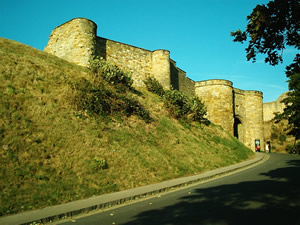
The gatehouse seen from the approach [Enlarge]
View map (TA 049 892): Multimap | Google | Live Local
In some ways the mighty headland of Scarborough castle might be seen as a potted guide to the last few thousand years of military activity. Always the 16 acres of headland, rising 300 feet out the sea and reachable by only a narrow spur of rock, must have seemed a safe refuge. The first evidence of human activity on the headland dates back to between 2100 BC and 1600 BC. In the fourth century a fortified Roman signal tower, part of the remains of which can still be seen, was built at the sea edge, ready to warn of invasion. Later the headland formed an important Viking stronghold mentioned in several Icelandic sagas. As Harald Hardrada sailed down the coast towards his fateful battle at Stamford Bridge he met stiff resistance at Scarborough. He built a bonfire on the rock above the town and flug blazing brands onto the houses below. It wasn't too long later, after the Conqueror had succeded where hardrada failed, that the great castle of Scarborough was established on the proven strength of the headland. The castle would be held by Kings, be besieged during the Pilgrmage of Grace and the English civil war, serve as a prison (the fate of many castle) for a time and finally meet the modern age when bombarded by first world war German war ships. Yet still the casual observer cannot help but be impressed by its continued majesty, standing guardian and lord above the little seaside town below.
The medieval castle was founded in 1135 by William Le Gros, Earl of Albermarle. When Henry II came to the throne he reclaimed it for the crown, for it had been built on a Royal manor. He created a fortified inner bailey, protected by a wall and ditch stretching across the castle plateau. This was entered via one of two gates, one northern and one southern. There is little to see now in the inner bailey, other than the towering and shattered remains of Henry's keep. However, some archeoligical evidence, and the fact the keep stands at a strange angle compared to the rest of the castle, suggest that once it contained much more. A regular courtyard probably existed, into one corner of which the keep was then built. The removal of the courtyard then left the isolated keep, skewed in it orientation. Some of the courtyard masonary may have been reused in the buildings of King John. His demolishing of the courtyard would explain the building of a second hall within the inner bailey, against the outer curtain at the southern corner of the inner bailey. The hall adjoined one of the curtain towers (which strangely had foundations layed out as a D-shaped tower but was built as a polyangular towe) and was itself replaced by a kitchen, brewhouse and bakehouse in the 14th century. The base of an oven can still be seen. The other main surviving feature of the inner bailey is a well, over 150 ft (46 m) deep, stone lined for the first 68 ft (21 m) before giving way to natural rock.
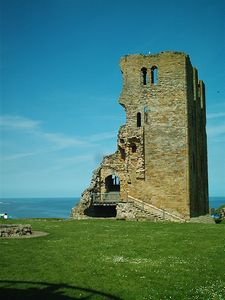
The towering keep seen from the inner bailey [Enlarge]
Of course the inner bailey, and indeed the whole castle, is dominated by the huge bulk of the keep, built between 1159 and 1169. It overlooks the town and commands the barbican entrance to the castle. At over 90 feethigh and with walls 12 feet thick even in its ruined state it appears formidable. In fact the keep is only ruined thanks to an intense bombardment during the civil war siege of 1645, which finally caused the west wall to collapse and leave it in its present open sided and roofless state (despite this failure early in the siege, the castle held out for another month). The original structure had the familiar first story entrance, reached by an external stair along the southern side which ended in a forebuilding which also contained a chapel. The entrance was further complicated by a need to walk clockwise around the entire building in an upward spiral form the barbican to the forebuilding stair. A thin tower stood at each corner, with a turret rising above the battlements. Buttress like projections ran down the centre of the north, east and west faces (the staircase was in the way on the south), the eastern and northern ones terminating in small, solid turrets at the battlement level. The western such feature actually contained a spiral stair to form a fifth projecting turret. Three levels of windows are now visible, though internally a fourth blocked level can been seen in the north face of the basement. The levels of the keep were connected by a spiral stair on the lost west side. The upper level of the keep was probably a dummy level, raised up around the roof to protect it. The other floors contained the usual large hall and chambers within the corner towers.
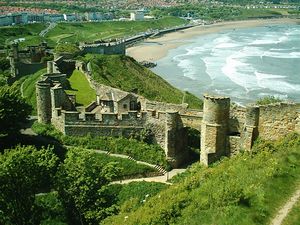
A view from the curtain looking down on the barbican and causeway [Enlarge]
Whilst the inner bailey and keep offered sanctum it would have taken a determined attacker to reach that far. The first line of defence is the barbican defending the only approach. It strengthens the narrow rock causeway which forms the only link to the castle headland. The barbican was first referneced in 1175 but most of the existing features are later (though difficult to determine accurately). The road from the barbican gatehouse up was surrounded by walls up to 18 feet high. Half way up stood a central gate tower built by Henry III in 1243–5, with a drawbridge to either side (now replaced with stone bridges) and double portcullis. Four smaller turrets were also present at the corners of the drawbridge pits. To enter the castle proper one had to pass another, now lost, gate immediatly below the keep. From here the curtain once encircled the entire headland before meeting up again with the gate.
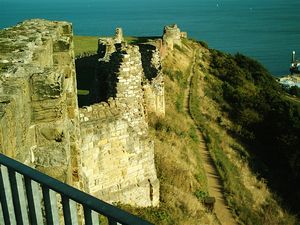
The curtain wall seen stretching away from the viewing platform [Enlarge]
The headland was originally surrounded by a protective curtain wall. The remaining part overlooks the town above a massive double ditch. The surviving wall was built by King John in 1202–12, replacing the earlier 12th century defences. Several towers punctuate the wall, with a D-plan unusual at a time when square or polyagonal towers were much more common. The southern towers (with the exception of two 14th century turrets) are internally hollow, allowing for floors to be inserted to create two story high structures, with arrow slits at each level and crowned by a battlemented wall walk. There is a change in design to the north of the junction with the inner bailey wall, the towers further north being solid with no internal chambers. This suggests the northern section, enclosing the inner bailey, was built first. In 1206–07 the expenditure on the castle dropped to nothing (for no obvious reason), which probably corresponds to the break in construction and change of design. The south end of this section of curtain was washed away when the cliff collapsed in 1730s, taking the Cockhyll Tower (a large polygonal tower) into sea. Just short of what is now the cliff edge is a sally port. This offers access to (an originally covered) staircase leading to the South Steel Battery, a gun emplacement built 1643 and enlarged 1652–7, designed to protect the town's harbour. The sally port and covered stair were probably not added until 1745 however. A collapse in 1847 and further erosion have rendered the battery unstable.
In the southern section of the curtain wall stands the ruinous remains of Mosdale Hall, King John's Chamber Block, built 1210–1211. This was a two story building with a partitioning wall creating a large and small chamber on each level. An additional room was provided at each level within a polygonal curtain wall tower at the northern end. A latrine pit exists at the southern end. The principle rooms comprising the royal chambers and possibly a chapel were on the upper story, now lost. Stone bases for columns to support fires within the rooms of this upper story are still visible, as are stone projections which probably supported external stairs and porches leading to the top floor. The whole was decorated with large windows and external buttresses. A 1361 survey for Edward III indicates the "e;Queen's Chambers"e; as being located here but by a 1538 survey the bulding was in ruins. The building was eventually converted into a barrack block after the Jacobite rebellion of 1745. The medieval masonary was encased in brick and a building on three floors created. It was badly damaged in the German shelling of 1914 and the barrack was demolished, the brick being stripped away from all but the exterior, where it still marks the halls location
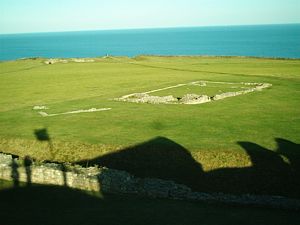
The foundations of King's Hall, with the Roman signal station site in the background, seen from the inner bailey [Enlarge]
The large proportion of the headland today is an open, grassy area over which a biting wind may blow from the North Sea on even the brightest days. Close to King John's Chamber lies the remains of the foundations of the King's Hall, also built by John. Though little remains the layout is clearly discernable form the foundations. The roof was supported on two rows of poles, the positions of which can still be seen in the grass, the stone base for one still existing. To the northwest, low end, can be seen the classic layout of three doorways. Those to the side led to a buttery and pantry while the centre accessed a corridor running to the kitchen (which was set apart from the hall to reduce the risk from fire). These doorways would have been hidden from the main hall behind a screen. The main entrance to the building was also behind this screen. In the 14th century an additional wall with external buttresses was added to divide the hall in two.
The other interesting feature in the expanse of the headland sits right against the sea cliff edge. Indeed, erosion has taken its toll. Here was the sight of the Roman signal tower, the remains confused by those of a Chapel of Our Lady built over the top and a domestic house. The Roman signal station was itself built over signs of Iron Age activity dating back to 800–500 BC. The signal station can be made out in the concentric square plan grass mounds, partly lost to the sea. The masonary remains are a confused and ill understood mixture of the chapel and house form various dates, the oldest chapel remains dating to around the year 1000. A well is known to have been associated with the chapel but there are actually two wells present; the larger is underground in a medieval vault (in which an 18th century water tank was later built.
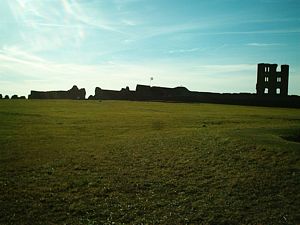
The keep is silhouetted against the sky, behind the inner bailey defences [Enlarge]
Unlike some castles Scarborough had to show its strength several times. There was a brief siege in 1312 when it was the rufuge of Edward II's favourite Piers Gaveston. Later it was held succesfully by Sir Ralph Eure during the Pilgrimage of Grace, when it was besieged by the locals. It was also at Scarborough the Thomas Stafford declared himself Protector of the Realm, hoping to incite revolt against Queen Mary. On this occasion though the castle was taken within six days and Stafford captured. With the joining of England and Scotland it seemed for a while that the long fortress history of Scarborough might be drawing to an end. Indeed the headland was sold off and rented out as pasture. Like most castles though it found a sudden reuse as the Civil War broke out. Scarborough was of great strategic importance both in controlling coastal trade and as a supply route to York. Twice it was held for the Royalist, though—typically of the period— because its occupiers changed sides. It was during the first of these sieges that the Parlimentarians guns shattered the keep in two. It took a further five months before the castle finally surrendered though, it's defender Sir High Cholmley finally running out of gunpowder, money and food (and men!). Perhaps foolishly Parliment repaired the castle, intending to use it themselves, only for another switch of alliegence to find it once more besieged. Once it was finally taken again a slighting was ordered but the castle was saved by the opposition of the town's folk.
Remarkably that wasn't the end of Scarborough's military service. Having served as a prison the Jacobite rebellion caused a barrack block to be constructed within Mosdale Hall, encasing it in red brick. More action was to come though as on 16th December 1914 the German warships Derrflinger and Von der Tann bombarded castle and town for fifteen minutes, damaging the barracks block to the point where its demolishion was eventually needed.
Having survived thousands of years of military occupation and some of the bloodiest times of the land Scarborough finally found piece, so that today it offers a pleasant point for a picnic, if one can find shelter from the winds, surrounded by reminders of its power.
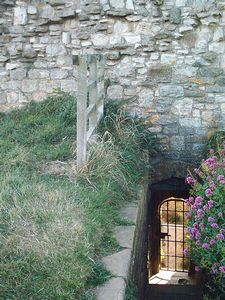
The sally port at the southern end of the curtain wall, which led via a covered staircase to the South Steel Battery[Enlarge]
Sources:
- Personal visit
- J. A. A. Goodall, Scarborough Castle: Guide Book, English Heritage (2000) ISBN: 1 85074 786 5
- Castle Explorer
- Castle UK
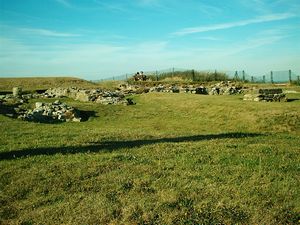
Confused Roman and medieval remains cling to the North Sea cliff edge [Enlarge]
Photograph Gallery (yet more photos!)